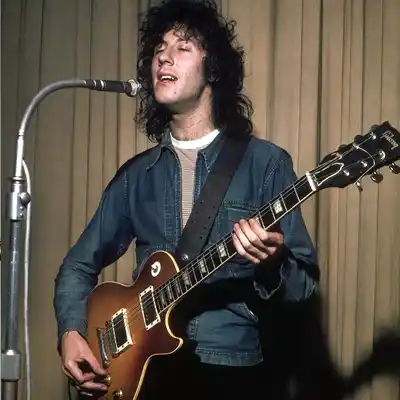
Peter Green – The Unsung Hero of Blues Rock
Often lurking in the shadows of his more flamboyant contemporaries, Peter Green’s influence has been vast, albeit sometimes understated.
For those in the know, Green’s work with Fleetwood Mac and his sublime solo efforts stand as some of the most soulful sounds to ever emerge from six strings.
So, let’s discover why Peter Green deserves a whole lot more limelight.
Peter Green
A Bluesy Beginning
Peter Allen Greenbaum was Born in 1946. His introduction to music was, like many of his peers, through the blues. Picking up the guitar as a young boy, he soon began absorbing the styles of greats like Muddy Waters and B.B. King. However, it wasn’t just about emulation for Green. He took the essence of the blues and infused it with his own unique touch, creating a sound that was instantly recognizable.
Fleetwood Mac
Before they were the juggernaut of pop-rock in the ‘70s and ‘80s, Fleetwood Mac was a blues band. Peter Green joined the band in 1967 and his influence was immediate. Hits like “Albatross,” “Oh Well,” and “Black Magic Woman” (the same song that Santana turned into a global smash) all bore the unmistakable mark of Green’s genius.
What made Green stand out, especially during his Fleetwood Mac days, was his restraint. In an era where guitarists were often going bigger, louder, and more extravagant, Green opted for a less-is-more approach. His solos were never about showcasing technical prowess (though he had plenty of it) but about conveying emotion.
Peter and “Greeny”
Peter Green’s legendary 1959 Gibson Les Paul, known among fans as “Greeny,” was central to his sound. There’s a lot of lore around how he achieved his signature tone. Some say it was due to a reversed pickup, others believe it was just his fingers.
Whatever the reason, his sound was distinctive: warm, sustain-heavy, and hauntingly beautiful. This unique tone became his signature, setting him apart from the crowd of British blues guitarists of the era.
The Fleetwood Mac Split and Its Impact
Though the world knew Fleetwood Mac as a unified entity, behind the scenes, things weren’t always so harmonious. It wasn’t just the internal dynamics; external pressures were mounting too.
The ‘60s and ‘70s music scene was notorious for its excesses, and many artists got caught in that whirlwind. Peter Green was no exception.
The pressures of constant touring, recording, and being in the public eye began to weigh on him. There were tales of his experimenting with psychedelics which further exacerbated his growing discomfort with the trappings of fame. It’s speculated that a particularly bad LSD trip during a party in Germany profoundly affected him.
Soon after, he grew disenchanted with the music industry and the capitalist machinery that profited from it. He questioned the need for accumulating wealth, leading to his famous quote:
“I want to give my money away, but no one will let me.”
Green’s spiraling mental health eventually led to his departure from Fleetwood Mac in 1970. It was a significant blow to the band. While they eventually regrouped and found worldwide fame with a new lineup, Peter Green’s exit marked the end of Fleetwood Mac’s original blues era.
A Career Cut Short
By the early ‘70s, Peter Green’s journey with Fleetwood Mac came to an end. Personal issues, including struggles with his mental health, led to his departure. It’s one of the rock world’s great tragedies. Who knows what more he could have achieved had circumstances been different?
However, while his time with the Mac was over, his musical journey was far from done.
In the years that followed, Green’s output was sporadic. He made occasional appearances and released a handful of solo albums, like “In the Skies” and “Little Dreamer.” While these didn’t achieve the same commercial success as his work with Fleetwood Mac, they further showcased his undeniable talent.
Post-Fleetwood Mac, Green led a life far removed from the rockstar image. There were periods of hospitalization, bouts of reclusiveness, and a retreat from the public eye. But the music in him never truly faded.
By the late ’70s and early ’80s, there were glimmers of a comeback. Peter Green’s Splinter Group formed in the late ’90s, marked his return to the touring and recording scene. Though he was older and perhaps a tad rustier, fans worldwide rejoiced at the chance to see their hero in action once again.
The Splinter Group albums, while not achieving the massive success of his Fleetwood Mac days, were critical in reestablishing Green in the music scene. They offered a mix of original compositions and classic blues covers.
Tributes and Legacy
Peter Green’s passing in 2020 was felt deeply across the music community. Artists from all corners of the industry paid their respects, from contemporaries like Mick Fleetwood and Carlos Santana to newer generation musicians. Such widespread adulation was a testament to Green’s lasting influence.
Guitarists from various genres, from heavy metal to indie rock, have cited him as an influence. Kirk Hammett of Metallica, for instance, is a noted fan and is the current owner of “Greeny.”
His guitar playing, marked by its emotive quality, has been a source of inspiration for countless guitarists. The beauty in Green’s playing wasn’t just in his mastery of the instrument but in his ability to convey profound emotions through it.
In a world of loud, Peter Green chose to speak softly, letting his guitar do the talking. And, what a beautiful conversation it was.
